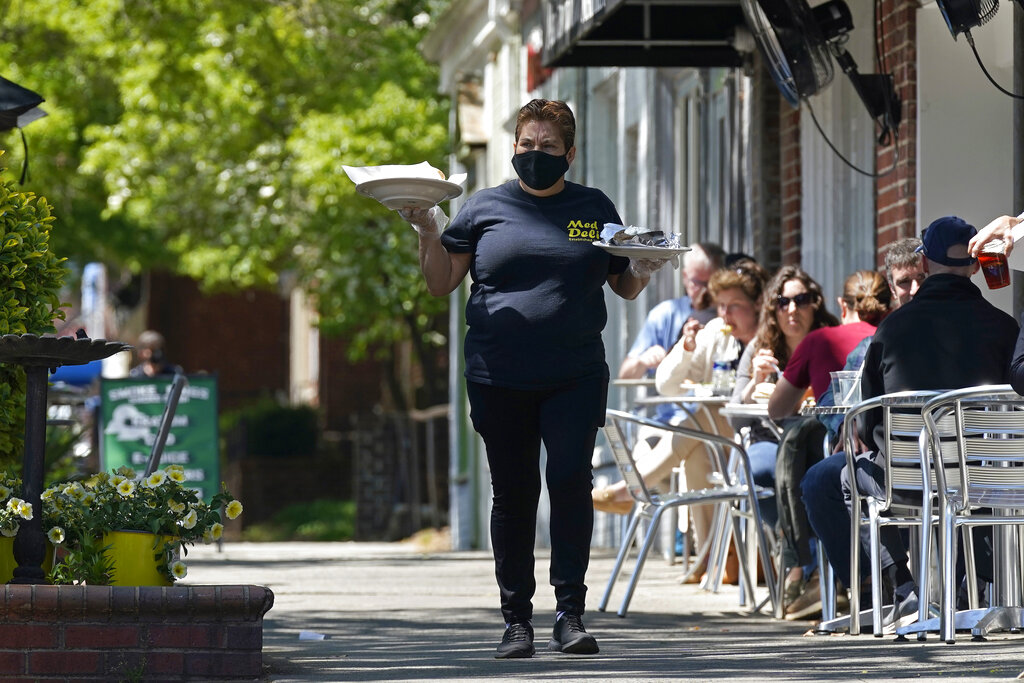
WASHINGTON | Powered by consumers, the U.S. economy grew at a brisk 6.4% annual rate last quarter — a show of strength fueled by government aid and declining viral cases that could drive further gains as the nation rebounds with unusual speed from the pandemic recession.
The nation’s gross domestic product — its total output of goods and services — accelerated in the January-March quarter from a 4.3% annual gain in the last quarter of 2020, the government said Thursday. Growth in the current April-June period is expected to be faster still: Some economists say it could reach a 10% annual pace or more, driven by a surge in people traveling, shopping, dining out and otherwise resuming their spending habits.
The government also said Thursday that the number of Americans seeking unemployment aid reached a new pandemic low last week. Though layoffs remain elevated, they are steadily easing as the economy more fully reopens.
All told, the latest figures point to a remarkably fast recovery from the devastating recession that ripped through the economy last year on the heels of the coronavirus and cost tens of millions of Americans their jobs. Economists say that widespread vaccinations, the reopening of more businesses, a huge infusion of federal spending and healthy job gains should help sustain steady growth. For 2021 as a whole, they expect the economy to expand close to 7%, which would mark the fastest calendar-year growth since 1984.
A major reason for the brightening expectations is the record-level spending that is poised to flow into the economy. A $1.9 trillion package that President Joe Biden got through Congress in March provided, among other rescue aid, $1,400 stimulus payments to most adults.
On top of that, Biden is proposing two additional huge spending plans: a $2.3 trillion infrastructure package and a $1.8 trillion investment in children, families and education that the president promoted Wednesday night in his first address to a joint session of Congress.
The Federal Reserve’s ultra-low interest-rate policy, which is intended to encourage borrowing and spending, has provided significant support, too. In fact, the economy is expected to expand so fast that some economists have raised concerns that it could ignite inflation.
In part, this is because stronger demand has caused supply bottlenecks and shortages of some goods and components, notably semiconductors, which are critical to the auto, technology and medical device industries, among others.
At a news conference Wednesday after the Fed’s latest policy meeting, though, Chair Jerome Powell reiterated his confidence that any surge in inflation would prove temporary. And he said the Fed wants to see a substantial and sustained recovery before it would consider withdrawing its economic support. In the meantime, Powell made clear, the central bank isn’t even close to beginning a pullback in its ultra-low rate policies.
The strength of the rebounding U.S. economy has been particularly striking given the scope of damage the pandemic inflicted on it beginning in March of last year. With businesses all but shut down, the economy contracted at a record annual pace of 31% in the April-June quarter of last year before rebounding sharply in the subsequent months.
“The economy is on fire,” Sung Won Sohn, a finance and economics professor at Loyola Marymount University, said before Thursday’s GDP report was released. “It is being fueled by the vaccine, which is the best economic stimulus we have, plus massive government spending.”
In recent weeks, the economic gains have become increasingly evident. In March, U.S. employers added 916,000 jobs — the biggest burst of hiring since August. At the same time, the pace of layoffs has dwindled, retail spending has surged, manufacturing output is up and consumer confidence has reached its highest point since the pandemic began.
Thursday’s GDP report showed that consumer spending, which accounts for more than two-thirds of the economy, surged at a 10.7% annual rate in the January-March quarter, a significant acceleration after spending had slowed to a 2.3% annual gain in the final three months of last year.
Business investment rose at a strong annual rate of nearly 10%, reflecting a burst of spending on equipment. The residential sector, which has been a standout performer in the last year thanks to ultra-low mortgage rates, grew at a roughly 11% annual rate in the first quarter, still solid but down from the fourth quarter.
Last quarter, government spending grew at a 6.3% annual rate after two straight declines that had reflected weakness at the state and local level as the pandemic recession shrank tax revenue.
Businesses did slow their pace of inventory restocking in the January-March quarter, which shaved 2.6 percentage points from the quarter’s growth. And a rising trade deficit diminished growth by 0.8 percentage point.
Mark Zandi, chief economist at Moody’s Analytics, said before Thursday’s GDP report was released that all signs point to an economic boom this year, fueled by heavy government support and a flood of pent-up consumer demand as the economy further reopens.
“This should be a gangbuster year,” Zandi said. “I have been forecasting the economy for almost 30 years, and I can’t remember a time when I have been as confident as I am today.”
"last" - Google News
April 30, 2021 at 12:33AM
https://ift.tt/3vwcC5i
US economy accelerated at a robust 6.4% rate last quarter - Sentinel Colorado
"last" - Google News
https://ift.tt/2rbmsh7
https://ift.tt/2Wq6qvt
Bagikan Berita Ini















0 Response to "US economy accelerated at a robust 6.4% rate last quarter - Sentinel Colorado"
Post a Comment